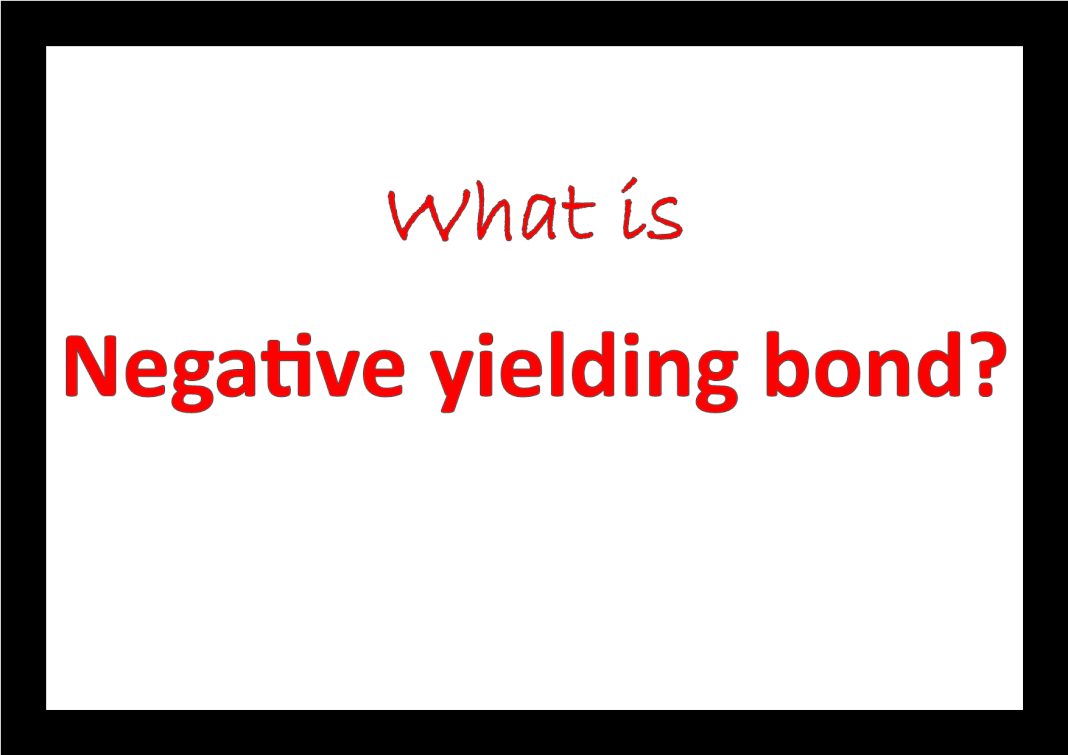In the context of the current covid pandemic, several interesting economic developments are taking place and one of them is the large scale selling of negative yielding bonds. A negative bond yield is a bond whose maturity price is lower than the purchase price. In this case, as the bond’s issue price is higher than the price the bond buyer is getting at its maturity, there is the negative yield.
Negative yield bond can generally happen in two ways.
(1) Bond yields of the currently traded bond are negative. For example, in the market you buy a bond with Rs 110, but its maturity price is Rs 100. Interest rate of this bond is low and inadequate. to compensate the Rs 10 gap.
|
A hypothetical negative yielding bond |
|
| Maturity | 5 years |
| Bond purchase price | Rs 105 |
| Coupon rate of interest | 0% |
| Face value at maturity | Rs 100 |
(2) Central banks are issuing new bonds that have low maturity price compared to its issue price.
An example for negative bond yield is the recently issued Chinese negative yielding Euro bond. The Chinese Euro bond offers an interest rate of -0.152% for five-year bond and 0.38% and 0.664% respectively for 10 year and 15 years bonds.
Why negative yielding bond in the current context?
The volume of negative yielding bonds is rising globally in the context of the covid induced economic uncertainty, existing low interest rate trends, high liquidity in the global economy, appreciation prospects of some currencies, asset diversification compulsion of the big institutional investors, prospects of deflation etc. In the context of these factors, negative interest rate became a trend in several economies especially in the developed regions.
Actually, the negative yielding bonds are just accommodating the recession specific adverse economic environment. Since the growth prospects is low and since there is large scale liquidity, return on any investment will be low as well. When everywhere, return (interest rate etc) is low, some assets can have negative yields.
Here, one big mission for the large fund managers like central banks and is to keep the value of their funds intact by insulating their money from uncertain economic outcome. Given that they manage huge funds, the option for them to make their investment is low. Here, even if the interest rate is negative, the conventional reliable avenue of government securities that gives zero income default is an important one.
How to understand negative yielding bonds?
At first, we may question the logic of negative yielding bonds. Our questions will be who will buy such bonds? Why people buy such negative yielding bonds and who are issuing such bonds?
First, we should understand that negative yielding bonds are quite unusual and not common. Most importantly, a set of current factors and their combined working have produced a conducive environment of making some of the existing bonds negative yielding and similarly tempted big players like the governments and central banks to issue bonds with negative yields.
Analysing the working of negative yielding bond from the indian context need special thinking. This is because in India, there is scarcity of funds and there are large number of entities and individuals and even the government that need money. Here, negative interest-bearing bonds is not a possibility.
Hence, when we are questioning the logic of people buying bonds that gives you lower price in the future compared to the price for which we bought, take two important factors.
First, these bonds are mostly issued in the West where you have to consider the environmental factors. There is huge liquidity overhang (means, tremendous volume of funds with large investment entities like insurance companies, pension funds etc. There, equities will have low return and even they may crash in the context of the recession hit economies. Even indices falling by 30-40% is a possibility in the context of deep recession. At present, the indices run high and stable only because of the huge liquidity provided by central banks in the context of the Covid crisis.
Secondly, the entities investing in these negative yielding bonds are not petty retail investors. We can never understand the investment mentality of going after the negative interest-bearing bond with a retail investor mindset. Take of the case of big entities like central banks and institutions like insurance companies, pension funds, mutual funds etc. They have huge money with them. The investment avenues for them to deploy their funds may be limited in the context of the recession. Equities are unreliable, most corporate bonds may be turned risky. Here, what critical factor is that you have to make your funds safe by parking the money in government bonds that gives surety. Remember that already, the rate of interest is very low or near zero or sub-zero. So, parking your big money as a fund manager in assets that have stable but with small loss is better than going after uncert ain equities and other assets.
ain equities and other assets.









